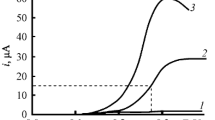Summary
The reaction between phenols and N,N-diethyl-p-benzoquinonediimine was examined for its applicability in analytical chemistry. As in natural formation of higher molecular phenolic compounds, nucleophilic, activated, sterically not hindered positions of the aromatic ring of phenols are directly involved in this reaction. Furthermore, the resulting indoanilines are electrochemically active coloured compounds, which undergo reversible oxidation and reduction.
The voltammetric conduction of indoaniline formation does not show the problems involved in direct anodic oxidation of phenols, i.e. uncontrolled follow-up reactions and electrodepoisoning. The hydrolysis of the diimine itself and subsequent colour formation are avoided by proper choice of pH, temperature and voltage sweep-rate.
The method is desribed with phenol as an example. For evaluation the peak current of indoaniline reduction is taken. The resulting calibration curve is linear for phenol concentrations between 10−4 and 10−3M. The course of the reaction of N,N-diethyl-p-benzoquinonediimine with naturally occurring phenolic compounds is illustrated with catechol serving as a model.
Zusammenfassung
Die Reaktion zwischen Phenolen und N,N-DiÄthyl-p-benzochinondiimin zu Indoanilinen wurde auf ihre Eignung für analytische Zwecke untersucht. An dieser Reaktion sind, wie bei der natürlichen Entstehung höhermolekularer phenolischer Verbindungen, nucleophile, durch Substituenten aktivierte, sterisch nicht gehinderte Stellen der aromatischen Ringe der Phenole direkt beteiligt. Weiter sind die entstehenden Indoaniline elektrochemisch aktive Farbstoffe, die reversible Redoxreaktionen eingehen. Die voltammetrische Reaktionsführung der Indoanilinbildung vermag die Probleme der direkten anodischen Oxidation bei der Phenolanalyse (nicht kontrollierbare Folgereaktionen, Elektrodenvergiftung) zu umgehen. Die Hydrolyse und Eigenkopplung des Diimins wird durch die Wahl geeigneter pH, Temperatur und Spannungsvorschubgeschwindigkeit — Bedingungen vermieden.
Die Methode wird am Beispiel des Phenols illustriert. Die Auswertung erfolgt über den Spitzenstromwert der Indoanilinreduktion. Die Eichkurve für Phenolkonzentrationen zwischen 10−4 und 10−3 Mol/l verlÄuft linear. Der Verlauf der Reaktion bei natürlichen, im Pflanzenmaterial vorkommenden phenolischen Verbindungen wird am Beispiel des Catechins gezeigt.
Similar content being viewed by others
Literatur
Adams, R. N.: Elektrochemistry at Solid Electrodes. New York: Marcel Dekker Inc. 1969
Appleby, A. J.: J. Electrochem. Soc. 120, 1205 (1973)
Böld, W., Breiter, M.: Electrochim. Acta 5, 145 (1961)
Breiter, M.: Electrochim. Acta 7, 25 (1962)
Bub, F. P., Wisser, K., Lorenz, W. J., Heimann, W.: Z. Elektrochem. Ber. Bunsenges. Physik. Chem. 77, 823 (1973)
Corbett, J. F.: Anal. Chem. 47, 308 (1975)
Eggers, J., Freiser, H.: Z. Elektrochem. Ber. Bunsenges. Physik. Chem. 60, 372 (1956)
Eichinger, G.: Diss., Fak. Allg. Wiss., T. U. München (1972)
Ferro, C. M., Calandra, A. J., Arvia, A. J.: J. Electroanal. Chem. 55, 291 (1974)
Gaylor, V. F., Elving, D. J.: Anal. Chem. 25, 1078 (1953)
Hawley, D., Adams, R. N.:J. Electroanal. Chem. 8, 163 (1964)
Hedenburg, J. F., Freiser, H.: Anal. Chem. 25, 1355 (1953)
Pelizetti, E., Saini, G.: J. Photogr. Sci. 22, 49 (1974)
Rand, D. A. J., Woods, R. J.: J. Electroanal. Chem. 55, 375 (1974)
Sawyer, D. T., Roberts, J. L.: Experimental Electrochemistry for Chemists. New York: J. Wiley 1974
Suatoni, J. C., Snyper, R. E., Clark, R. O.: Anal. Chem. 33, 1894 (1961)
Tong, L. K. J.: J. Am. Chem. Soc. 90, 5164 (1968)
Tong, L. K. J., Glessmann, M. C.: J. Am. Chem. Soc. 79, 583 (1957)
Tong, L. K. J., Glessmann, M. C.: J. Am. Chem. Soc. 79, 592 (1957)
Tsuji, K.: Ann. N. Y. Acad. Sci. 153, 446 (1968)
Vermillon, F. J., Pearl, I.: J. Electrochem. Soc. 111, 1392 (1964)
Vitaminanalyse; Chemische Methoden. Darmstadt: E.Merck AG 1959
Vitum, P. W., Weissberger, A.: J. Photogr. Sci. 6, 157 (1958)
Will, F. G., Knorr, C. A.: Z. Elektrochem. Ber. Bunsenges. Physik. Chem. 64, 258 (1960)
Will, F. G., Knorr, C. A.: Z. Elektrochem. Ber. Bunsenges. Physik. Chem. 64, 270 (1960)
Author information
Authors and Affiliations
Additional information
Der Deutschen Forschungsgemeinschaft und dem Fonds der Chemie danken wir für die Förderung dieser Arbeit.
Rights and permissions
About this article
Cite this article
Drawert, F., Krempl, H., Osterrieder, W. et al. Die voltammetrische Reaktionsführung der Reaktion zwischen Phenolen und N,N-DiÄthyl-p-Phenylendiamin. Z. Anal. Chem. 290, 15–20 (1978). https://doi.org/10.1007/BF00468856
Received:
Issue Date:
DOI: https://doi.org/10.1007/BF00468856



